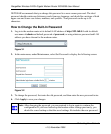
RangeMax Wireless-N DSL Gigabit Modem Router DGN3500 User Manual
Protecting Your Network 3-7
v1.0, November 2009
• To edit an existing rule, select its button on the left side of the table, and click Edit.
• To delete an existing rule, select its button on the left side of the table, and click Delete.
• To move an existing rule to a different position in the table, select its button on the left side of
the table, and click Move. At the prompt, enter the number of the desired new position and
click OK.
Inbound Rules (Port Forwarding)
Because the modem router uses Network Address Translation (NAT), your network presents only
one IP address to the Internet, and outside users cannot directly address any of your local
computers. However, by defining an inbound rule you can make a local server (for example, a Web
server or game server) visible and available to the Internet. The rule tells the modem router to
direct inbound traffic for a particular service to one local server based on the destination port
number. This is also known as port forwarding.
Figure 3-5
Note: Some residential broadband ISP accounts do not allow you to run any server
processes (such as a Web or FTP server) from your location. Your ISP might
periodically check for servers and might suspend your account if it discovers any
active services at your location. If you are unsure, refer to the acceptable use policy
of your ISP.


















